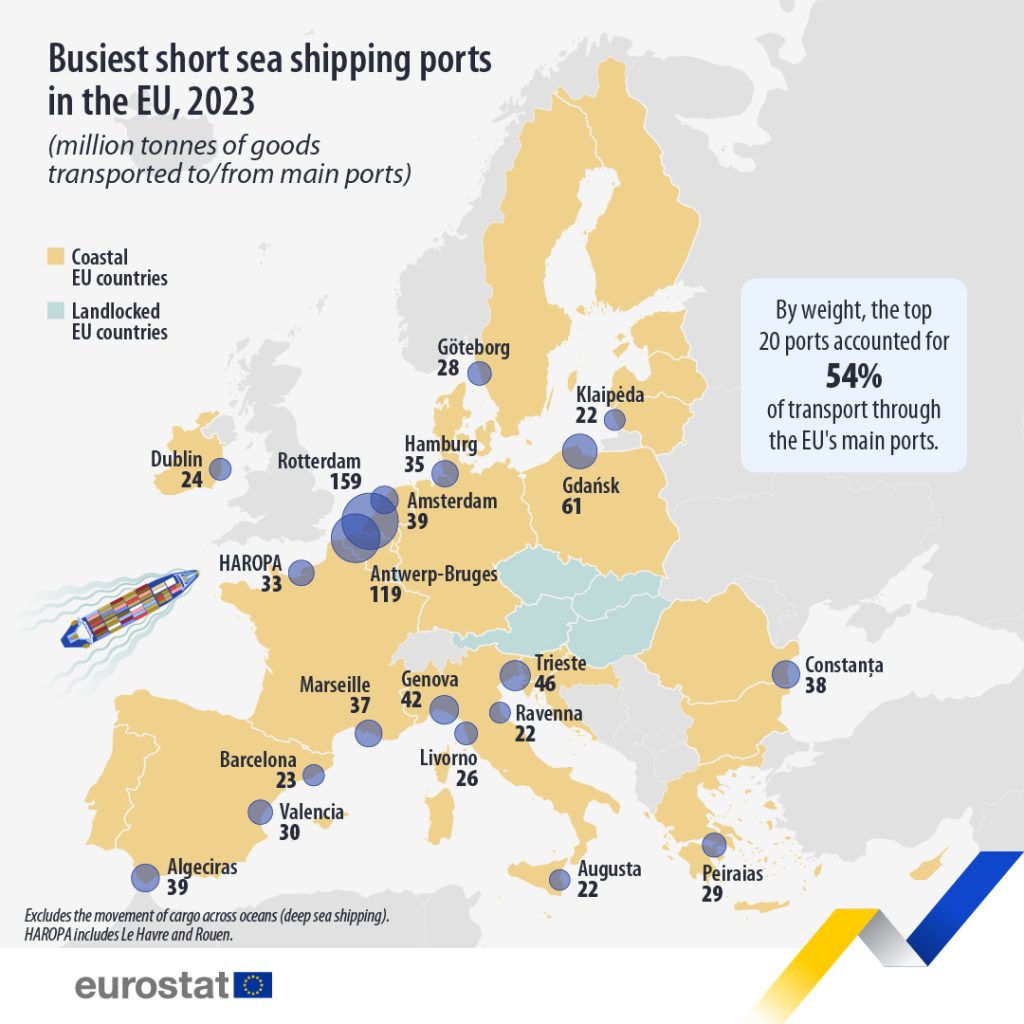Port Gdańsk among the European leaders. Third place in the short sea shipping ranking.

The Port of Gdańsk is among the top three largest ports in the European Union in terms of cargo handling for short sea shipping, according to the latest Eurostat report ‘Key figures for Europe – 2025 edition’. This is a stellar rise of two places from the position in 2022, allowing the Port of Gdańsk to overtake such well-known port centres as Trieste and Amsterdam.
According to the Eurostat data for 2023, 61 million tonnes of goods were handled at the Port of Gdańsk as part of short sea shipping (total cargo handling amounting up to 81 million tonnes), which allowed it reach the podium just behind the largest ports in Western Europe – Rotterdam (159 million tonnes) and Antwerp-Bruges (119 million tonnes). For comparison, Trieste closed the year with 46 million tonnes and Amsterdam with 39 million tonnes.
As recently as 2022, the Port of Gdańsk ranked 5th among the largest EU ports in short sea shipping. A year later, thanks to the dynamic growth in cargo handling, the port moved up to 3rd place, overtaking its competitors from southern and western Europe.
‘This is a huge success, which confirms the growing importance of the Port of Gdańsk as a strategic maritime gateway for the entire Europe. This high position is the result of the trust of our business partners, the hard work of the port’s employees and the consistent investment in infrastructure’, says Dorota Pyć, President of the Port of Gdańsk. ‘This proves that our efforts bring measurable results, and is an important signal to investors that the Port of Gdańsk is a modern, dynamically developing centre, ready to meet the growing demands of the market’.
A strong maritime Poland
Short Sea Shipping (SSS) covers maritime transport over relatively short distances – primarily between EU ports as well as to and from countries in the Mediterranean and Black Sea basins. It is a key transport segment for the Community’s economy – it accounted for 56.6% of total EU maritime freight transport in 2023.
The total weight of goods transported by SSS in the EU in 2023 amounted to 1.6 billion tonnes, a decrease of 5.4% compared to the previous year. It should be noted that as many as 16 of the 20 largest ports in the EU recorded a decline in cargo handling during this period. The largest declines were recorded in Amsterdam, Barcelona, Haropa and Rotterdam. One of the exceptions was the Port of Gdańsk, which had one of the highest growth rates in Europe (+40%).
This is the second-best result in Europe, second only to Taranto in Italy (+50%). For comparison, Genoa recorded an increase of 13.5%, while many leading ports, such as Rotterdam and Antwerp, faced downward trends.
The results of the Port of Gdańsk in the liquid fuels segment are particularly impressive, with cargo handling increasing by as much as 50% year-on-year, to a level of 31 million tonnes. In this area the Port of Gdańsk was among the leaders in Europe, ahead of such ports as Trieste.
Strategic gateway to Northern Europe
Eurostat emphasises that the development of ports is part of a larger trend in European trade routes shifting eastwards. Poland’s maritime infrastructure is becoming an increasingly important link connecting Northern and Central Europe with the North Sea and Baltic Sea basins.
The growing importance of the Port of Gdańsk is also the result of consistent investment in port and terminal infrastructure. The modernisation of quays, the development of the Baltic Hub container terminal, and investments in access infrastructure (road and rail) mean that the port not only increases its throughput but also improves its international competitiveness.
On a European Union scale, Poland belongs to the group of countries that recorded the highest growth in short sea shipping in 2023. According to Eurostat, Poland’s result increased by 21.6%, which places us on the podium next to Malta (+40.4%) and France (+22.6%).
This is an unprecedented success for the Polish port, which, alongside Rotterdam and Antwerp-Bruges, sets the direction for the development of European short sea shipping these days.



